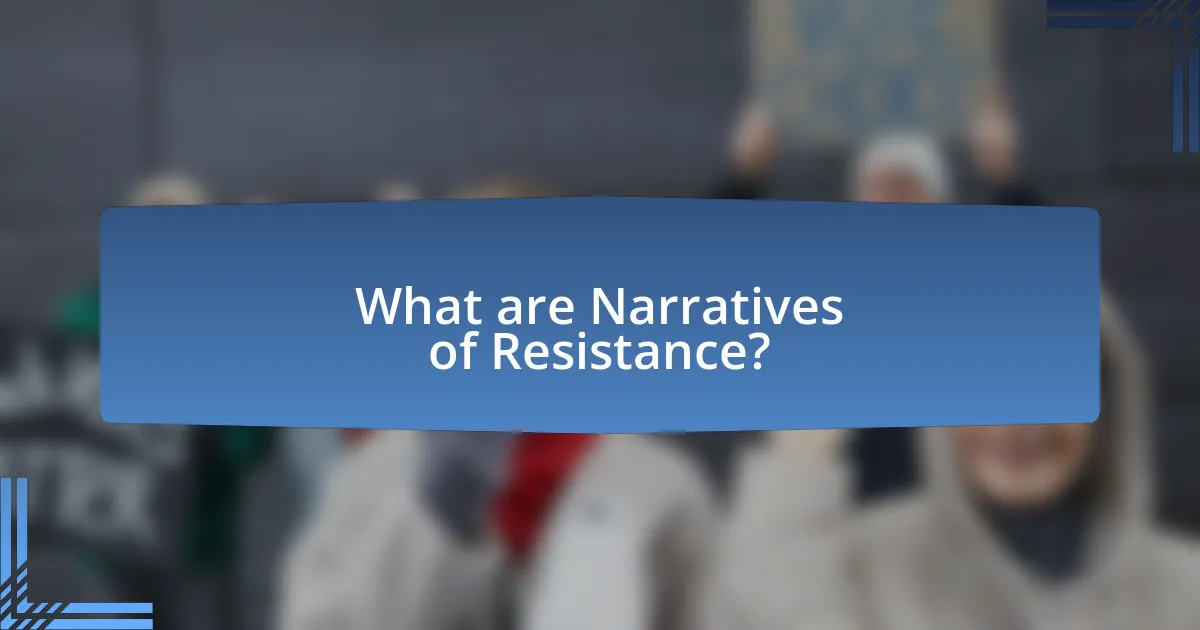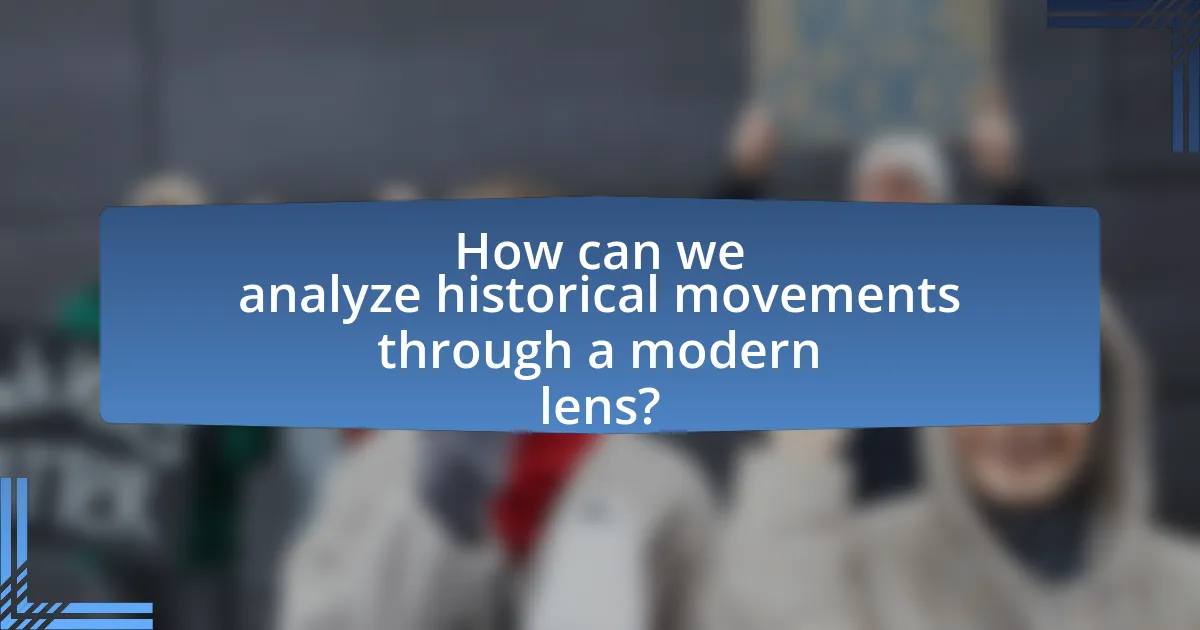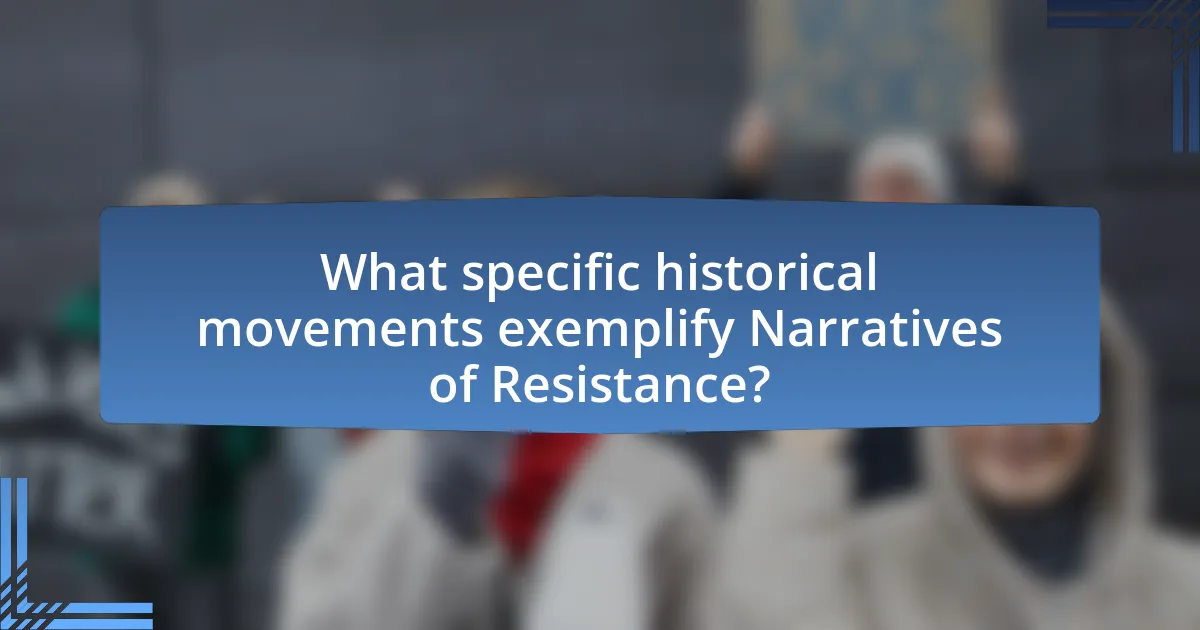Narratives of Resistance are accounts that articulate struggles against oppressive systems, often emerging from marginalized groups. This article examines how these narratives shape historical understanding, highlight key events, and contribute to contemporary social justice movements. It discusses the importance of personal stories, collective memory, and the role of technology in analyzing historical movements through a modern lens. Additionally, it explores the lessons learned from historical resistance, such as the Civil Rights Movement and the Women’s Suffrage Movement, and how these insights can inform current activism and enhance the effectiveness of modern resistance efforts.

What are Narratives of Resistance?
Narratives of Resistance are stories and accounts that articulate the struggles and opposition against oppressive systems or injustices. These narratives often emerge from marginalized groups and serve to highlight their experiences, resilience, and efforts to challenge dominant power structures. For example, the narratives surrounding the Civil Rights Movement in the United States illustrate how activists fought against racial segregation and discrimination, providing a historical context that informs contemporary discussions on social justice. Such narratives are crucial for understanding the complexities of resistance and the ongoing impact of historical movements on modern society.
How do Narratives of Resistance shape historical understanding?
Narratives of resistance shape historical understanding by providing alternative perspectives that challenge dominant historical narratives. These narratives highlight the experiences and struggles of marginalized groups, revealing the complexities of power dynamics and social change. For instance, the civil rights movement in the United States is often framed through the lens of prominent leaders like Martin Luther King Jr., but grassroots activism and local resistance efforts are equally crucial for understanding the movement’s impact. By incorporating these diverse voices, historians can better analyze the socio-political context and the multifaceted nature of resistance, leading to a more nuanced comprehension of history.
What key events are often highlighted in these narratives?
Key events often highlighted in narratives of resistance include significant protests, landmark legislation, and pivotal moments of civil disobedience. For example, the Civil Rights Movement in the United States prominently features events such as the March on Washington in 1963, where Martin Luther King Jr. delivered his “I Have a Dream” speech, and the passage of the Civil Rights Act of 1964, which outlawed discrimination based on race, color, religion, sex, or national origin. These events serve as critical touchpoints that illustrate the struggle for equality and justice, showcasing the collective efforts of individuals and groups to challenge systemic oppression.
How do personal stories contribute to the broader narrative?
Personal stories contribute to the broader narrative by providing individual perspectives that humanize historical events and movements. These narratives often illustrate the emotional and psychological experiences of those involved, making abstract concepts more relatable and impactful. For instance, during the Civil Rights Movement, personal accounts from activists like Rosa Parks and Martin Luther King Jr. highlighted the struggles and triumphs faced by individuals, thereby enriching the collective understanding of the movement’s significance. Such stories serve as vital evidence of the lived experiences behind historical events, reinforcing the importance of personal agency in shaping societal change.
Why are Narratives of Resistance important in contemporary society?
Narratives of Resistance are important in contemporary society because they provide frameworks for understanding and challenging systemic injustices. These narratives empower marginalized communities by validating their experiences and fostering solidarity, as seen in movements like Black Lives Matter, which draws on historical struggles against racism to advocate for social change. Furthermore, research indicates that storytelling can enhance collective memory and inspire activism, as demonstrated by the impact of narratives in the Civil Rights Movement, where personal accounts galvanized public support and legislative action.
What lessons can modern movements learn from historical resistance?
Modern movements can learn the importance of strategic organization and coalition-building from historical resistance movements. For instance, the Civil Rights Movement in the United States effectively utilized grassroots organizing and coalition-building among diverse groups to achieve significant legislative changes, such as the Civil Rights Act of 1964. This demonstrates that uniting various stakeholders can amplify voices and create a more powerful collective impact. Additionally, historical movements often relied on nonviolent resistance, as seen in Mahatma Gandhi’s approach during India’s struggle for independence, which proved effective in garnering public support and moral authority. These lessons highlight the necessity of strategic planning, unity, and nonviolent tactics in modern movements to achieve their goals effectively.
How do these narratives influence current social justice movements?
Narratives of resistance from historical movements significantly influence current social justice movements by providing frameworks for activism and solidarity. These narratives often highlight systemic injustices and empower marginalized communities to advocate for their rights, as seen in the Black Lives Matter movement, which draws on the civil rights struggles of the 1960s. Historical accounts, such as the Stonewall riots, serve as foundational stories that inspire contemporary LGBTQ+ activism, illustrating the importance of collective action against oppression. Furthermore, the use of social media to disseminate these narratives amplifies their reach, allowing for a broader engagement and mobilization of supporters, as evidenced by the viral spread of hashtags like #MeToo, which connects personal experiences of harassment to a larger societal issue.
What are the common themes found in Narratives of Resistance?
Common themes found in Narratives of Resistance include the struggle for justice, the assertion of identity, and the quest for autonomy. These narratives often highlight the collective action of marginalized groups fighting against oppression, as seen in historical movements like the Civil Rights Movement in the United States, where activists sought equality and justice through nonviolent protests. Additionally, the theme of identity is prevalent, as individuals and communities reclaim their cultural heritage and assert their rights, exemplified by Indigenous movements advocating for land and sovereignty. The quest for autonomy is also significant, as seen in anti-colonial struggles where nations sought independence from imperial powers, reflecting a universal desire for self-determination. These themes are interconnected and illustrate the resilience and agency of those who resist oppression.
How do themes of identity and belonging manifest in these narratives?
Themes of identity and belonging manifest in these narratives through the exploration of personal and collective experiences that shape individuals’ understanding of their place within society. These narratives often highlight the struggles faced by marginalized groups, illustrating how their identities are formed in opposition to dominant cultural narratives. For instance, historical movements such as the Civil Rights Movement in the United States showcase how individuals sought to assert their identity and claim belonging in a society that systematically excluded them. The testimonies and stories from activists reveal a deep connection to community and shared history, reinforcing the idea that identity is not only personal but also collective. This interplay between individual stories and broader social movements underscores the significance of belonging as a source of strength and resilience in the face of adversity.
What role does collective memory play in shaping these narratives?
Collective memory plays a crucial role in shaping narratives by influencing how communities remember and interpret historical events. This shared recollection helps to construct a collective identity and informs the values and beliefs of a group. For instance, the collective memory of the Civil Rights Movement in the United States has been instrumental in framing contemporary discussions about racial equality and social justice, as it highlights the struggles and achievements of past activists. Research by sociologist Maurice Halbwachs emphasizes that collective memory is not merely a reflection of the past but actively shapes present and future narratives, reinforcing the idea that historical movements are continuously reinterpreted through the lens of shared experiences and cultural contexts.

How can we analyze historical movements through a modern lens?
Analyzing historical movements through a modern lens involves applying contemporary frameworks, theories, and technologies to understand past events and their implications. For instance, social media analytics can reveal how historical narratives resonate with current audiences, while intersectionality can provide insights into the diverse experiences within movements. Historical events, such as the Civil Rights Movement, can be re-evaluated using modern concepts of social justice, highlighting ongoing struggles against systemic inequality. This approach allows for a nuanced understanding of how past movements inform present-day activism and societal change.
What methodologies are effective for examining these movements?
Qualitative methodologies, such as ethnography, oral history, and narrative analysis, are effective for examining historical movements. Ethnography allows researchers to immerse themselves in communities, capturing the lived experiences and cultural contexts of resistance movements. Oral history provides firsthand accounts from participants, preserving personal narratives that highlight the motivations and impacts of these movements. Narrative analysis enables the exploration of how stories shape collective identities and influence social change. These methodologies collectively offer a comprehensive understanding of the complexities and nuances inherent in historical resistance movements.
How does intersectionality enhance our understanding of resistance?
Intersectionality enhances our understanding of resistance by revealing how overlapping social identities, such as race, gender, and class, shape individuals’ experiences and strategies in resisting oppression. This framework allows for a more nuanced analysis of social movements, as it highlights that different groups face unique challenges and forms of discrimination, which informs their methods of resistance. For example, the Black feminist movement emphasizes the importance of addressing both racism and sexism, illustrating that resistance cannot be one-dimensional. Studies, such as those by Kimberlé Crenshaw, demonstrate that recognizing these intersections leads to more effective and inclusive resistance strategies, ultimately fostering solidarity among diverse groups fighting against systemic injustices.
What role does technology play in modern interpretations of historical movements?
Technology significantly influences modern interpretations of historical movements by providing new tools for analysis, dissemination, and engagement. Digital platforms enable historians and scholars to access vast archives, facilitating the examination of primary sources that were previously difficult to obtain. For instance, projects like the Digital Public Library of America and Europeana aggregate historical documents, making them accessible to a broader audience. Additionally, social media allows for the rapid sharing of interpretations and discussions, fostering public engagement and diverse perspectives on historical events. This democratization of information can reshape narratives, as seen in movements like Black Lives Matter, where technology amplifies voices and experiences that challenge traditional historical accounts.
Why is it crucial to contextualize historical movements in today’s world?
Contextualizing historical movements in today’s world is crucial because it allows for a deeper understanding of contemporary social issues and informs current activism. By examining the historical context of movements such as civil rights, feminism, or environmentalism, individuals can identify patterns, strategies, and outcomes that resonate with current struggles. For instance, the civil rights movement of the 1960s provides insights into systemic racism and the ongoing fight for racial equality, highlighting the importance of grassroots organizing and coalition-building. This historical perspective not only enriches the narrative of resistance but also equips modern activists with lessons learned from past successes and failures, ultimately fostering more effective advocacy in today’s socio-political landscape.
How do contemporary issues reflect the struggles of past movements?
Contemporary issues reflect the struggles of past movements by showcasing ongoing social injustices and the persistent fight for equality. For instance, the Black Lives Matter movement echoes the civil rights struggles of the 1960s, as both address systemic racism and police brutality. Historical events, such as the Selma to Montgomery marches, highlight the same themes of resistance against oppression that are evident in today’s protests against racial injustice. Additionally, the LGBTQ+ rights movement, which gained momentum in the 1970s, parallels current battles for transgender rights, illustrating how past advocacy informs present-day activism. These connections demonstrate that the foundational struggles of earlier movements continue to resonate, influencing contemporary discourse and action.
What impact does globalization have on the narratives of resistance?
Globalization significantly influences the narratives of resistance by facilitating the spread of ideas, cultures, and movements across borders. This interconnectedness allows local resistance movements to gain international visibility and support, as seen in the Arab Spring, where social media played a crucial role in mobilizing protests and sharing experiences globally. Furthermore, globalization often leads to the homogenization of cultures, prompting local communities to resist perceived threats to their identity, as evidenced by movements advocating for indigenous rights in response to global economic pressures. These dynamics illustrate how globalization shapes both the strategies and the narratives of resistance, making them more complex and interconnected.

What specific historical movements exemplify Narratives of Resistance?
Specific historical movements that exemplify Narratives of Resistance include the Civil Rights Movement in the United States, the anti-apartheid movement in South Africa, and the Indian independence movement. The Civil Rights Movement, particularly from the 1950s to the 1960s, aimed to end racial segregation and discrimination against African Americans, highlighted by events such as the Montgomery Bus Boycott and the March on Washington. The anti-apartheid movement, led by figures like Nelson Mandela, sought to dismantle institutionalized racial segregation in South Africa, culminating in the end of apartheid in the early 1990s. The Indian independence movement, characterized by leaders like Mahatma Gandhi, employed nonviolent resistance to challenge British colonial rule, achieving independence in 1947. Each of these movements utilized collective action and grassroots organizing to confront systemic oppression, making them key examples of resistance narratives in history.
How did the Civil Rights Movement shape modern resistance narratives?
The Civil Rights Movement significantly shaped modern resistance narratives by establishing frameworks for activism that emphasize nonviolent protest, grassroots organizing, and coalition-building. This movement, particularly through key events like the Montgomery Bus Boycott and the March on Washington, demonstrated the power of collective action and the importance of strategic communication in mobilizing public support. The principles of equality and justice articulated by leaders such as Martin Luther King Jr. continue to resonate in contemporary movements, such as Black Lives Matter, which adopt similar tactics of peaceful demonstration and social media engagement to address systemic injustices. The legacy of the Civil Rights Movement serves as a blueprint for modern resistance, illustrating how organized efforts can lead to substantial social change.
What key figures emerged from the Civil Rights Movement?
Key figures who emerged from the Civil Rights Movement include Martin Luther King Jr., Rosa Parks, Malcolm X, and John Lewis. Martin Luther King Jr. was a prominent leader known for his advocacy of nonviolent protest and his role in events such as the Montgomery Bus Boycott and the March on Washington, where he delivered the iconic “I Have a Dream” speech in 1963. Rosa Parks is celebrated for her pivotal act of defiance in 1955 when she refused to give up her bus seat, which sparked the Montgomery Bus Boycott. Malcolm X, a key figure in the Nation of Islam, advocated for black empowerment and was known for his more militant approach to civil rights. John Lewis, a leader in the Student Nonviolent Coordinating Committee (SNCC), played a crucial role in organizing protests and was a speaker at the March on Washington. These individuals significantly influenced the movement and contributed to the advancement of civil rights in the United States.
How did media representation influence public perception of the movement?
Media representation significantly shaped public perception of the movement by framing narratives that either supported or undermined its goals. For instance, during the Civil Rights Movement, television coverage of peaceful protests contrasted sharply with violent responses from authorities, leading to increased public sympathy and support for the movement. Studies, such as those conducted by the Pew Research Center, indicate that media portrayals can sway public opinion; in this case, the visibility of injustices faced by activists galvanized broader societal support. Furthermore, the portrayal of key figures in the movement, like Martin Luther King Jr., as moral leaders helped humanize the struggle, making it relatable to a wider audience. Thus, media representation played a crucial role in shaping the collective understanding and acceptance of the movement’s objectives.
What lessons can be learned from the Women’s Suffrage Movement?
The Women’s Suffrage Movement teaches the importance of persistent advocacy and coalition-building in achieving social change. This movement, which culminated in the 19th Amendment to the U.S. Constitution in 1920, demonstrates that sustained efforts, including protests, lobbying, and public awareness campaigns, can lead to significant legal and societal transformations. Historical evidence shows that the collaboration between diverse groups, such as women of different races and social classes, was crucial in amplifying their voices and demands. The movement’s success underscores the necessity of inclusive strategies and the power of grassroots mobilization in effecting change.
How did the movement’s strategies evolve over time?
The movement’s strategies evolved from initial grassroots organizing to more sophisticated, multi-faceted approaches. Early strategies focused on local community engagement and direct action, such as protests and sit-ins, which were effective in raising awareness and mobilizing support. Over time, movements began to incorporate digital platforms for broader outreach, utilizing social media to galvanize international support and coordinate actions. This shift was evident during events like the Arab Spring, where online activism played a crucial role in organizing protests. Additionally, movements increasingly adopted intersectional approaches, addressing various social justice issues simultaneously, which broadened their appeal and effectiveness. This evolution reflects a response to changing political landscapes and the need for adaptive strategies to maintain momentum and achieve goals.
What parallels can be drawn between the Suffrage Movement and today’s gender equality efforts?
The Suffrage Movement and today’s gender equality efforts both seek to dismantle systemic barriers to women’s rights and representation. Both movements emphasize the importance of advocacy, mobilization, and public awareness to challenge societal norms that perpetuate gender inequality. For instance, the Suffrage Movement fought for women’s right to vote, highlighting the necessity of political participation, while contemporary gender equality efforts focus on issues such as equal pay, reproductive rights, and combating gender-based violence. Historical data shows that the Suffrage Movement laid the groundwork for future feminist activism, as evidenced by the passage of the 19th Amendment in 1920, which granted women the right to vote in the United States. Similarly, current movements, such as the #MeToo movement, continue to build on this legacy by addressing ongoing injustices and advocating for comprehensive policy changes.
How do Indigenous movements illustrate Narratives of Resistance?
Indigenous movements illustrate Narratives of Resistance by actively challenging colonialism and asserting their rights to land, culture, and self-determination. These movements, such as the American Indian Movement in the 1960s and the Standing Rock protests against the Dakota Access Pipeline, exemplify resistance through organized activism, legal battles, and cultural revitalization efforts. For instance, the Standing Rock protests drew international attention to Indigenous rights and environmental issues, highlighting the ongoing struggle against systemic oppression and environmental degradation. This resistance is rooted in historical injustices, such as land dispossession and cultural erasure, which Indigenous communities continue to confront today.
What unique challenges do Indigenous movements face today?
Indigenous movements today face unique challenges such as systemic discrimination, loss of land, and cultural erasure. Systemic discrimination manifests in legal and political frameworks that often marginalize Indigenous voices, limiting their participation in decision-making processes. The loss of land continues to be a critical issue, as many Indigenous communities struggle against encroachments from industries like mining and logging, which threaten their ancestral territories. Cultural erasure is exacerbated by globalization and assimilation policies that undermine Indigenous languages and traditions. According to a report by the United Nations, Indigenous peoples are disproportionately affected by poverty and lack access to essential services, further complicating their efforts to advocate for rights and recognition.
How do these movements preserve cultural identity while resisting oppression?
Movements preserve cultural identity while resisting oppression by actively promoting and revitalizing cultural practices, languages, and traditions that are threatened by dominant societal forces. For instance, the Civil Rights Movement in the United States emphasized African American cultural heritage through music, art, and literature, which served as a means of asserting identity and unity against systemic racism. Additionally, Indigenous movements globally, such as the Zapatista movement in Mexico, focus on reclaiming traditional practices and languages, thereby reinforcing cultural identity while challenging colonial and oppressive structures. These actions not only foster community solidarity but also serve as a form of resistance by asserting the value and legitimacy of marginalized cultures in the face of oppression.
What practical insights can we gain from examining Narratives of Resistance?
Examining Narratives of Resistance provides practical insights into the strategies and motivations behind social movements. These narratives reveal how marginalized groups articulate their struggles, fostering solidarity and collective identity. For instance, the Civil Rights Movement in the United States utilized storytelling to highlight injustices, mobilizing support and influencing legislation, such as the Civil Rights Act of 1964. Additionally, analyzing these narratives helps identify patterns of resistance that can inform contemporary activism, demonstrating that historical context shapes current social justice efforts.
How can activists apply historical lessons to current movements?
Activists can apply historical lessons to current movements by analyzing past strategies, successes, and failures to inform their approaches. For instance, the civil rights movement of the 1960s utilized nonviolent protest and grassroots organizing, which can guide contemporary activists in building coalitions and mobilizing communities effectively. Historical examples, such as the use of social media in the Arab Spring, demonstrate the importance of adapting communication methods to reach wider audiences. By studying these precedents, activists can identify effective tactics and avoid repeating mistakes, thereby enhancing the impact of their current efforts.
What strategies can enhance the effectiveness of modern resistance efforts?
Modern resistance efforts can be enhanced through strategic coalition-building, effective communication, and leveraging technology. Coalition-building fosters unity among diverse groups, increasing collective strength and resources, as seen in movements like the Civil Rights Movement, where alliances across racial and social lines amplified impact. Effective communication, utilizing clear messaging and storytelling, engages broader audiences and mobilizes support, exemplified by the use of social media in recent protests, which has proven to rapidly disseminate information and rally participants. Additionally, leveraging technology, such as data analytics and digital platforms, allows for better organization and outreach, as demonstrated by the success of the Arab Spring, where social media played a crucial role in coordinating actions and spreading awareness. These strategies collectively enhance the effectiveness of modern resistance efforts by fostering collaboration, amplifying voices, and optimizing resource use.


